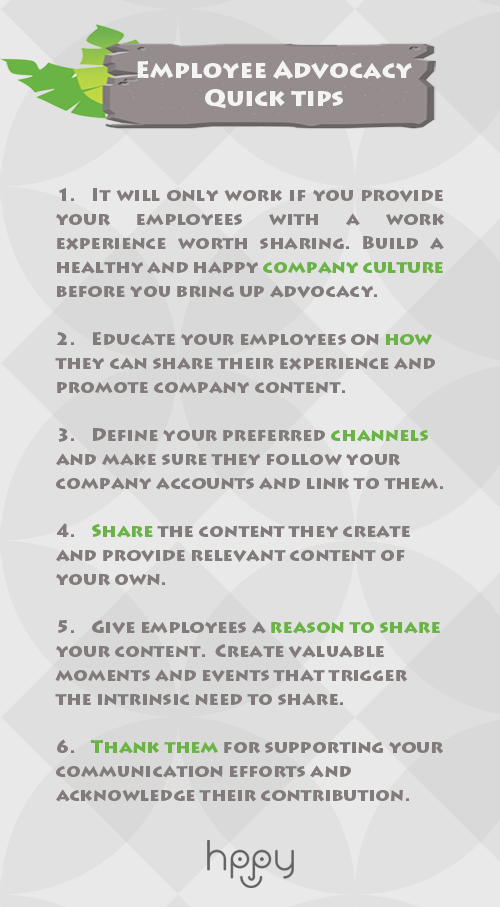We’ve always been very proud of our company culture and that serves as our best recruitment strategy. We talk about it whenever we get a chance. That’s why we were thrilled when SlideShare launched the #CultureCode campaign, making it easy for us to share our culture with the world.
We love Hppy because it’s more than job. Happiness at work comes naturally when you share the same values as the people you work with. You know what else came naturally? People wanting to connect with us just because we inspired them to love Hppy too.
People are really drawn to personal perceptions and genuine endorsements from regular people who love a product or a company. When my colleagues and I get a #gethppy moment, as we like to call them, we can’t help but tweet about it saying what made us happy. And that’s what attracted potential hires. Great, talented people who wanted to work with us and experience #gethppy moments of their own.
We were doing employee advocacy before it was cool
Employee advocacy means involving everyone in the company in your communications efforts, to share and endorse your company culture, events and thought leadership. Sharing, posting, commenting whenever they find something they love about their job.
We don’t have an employee advocacy program or a company policy on that. We just experience happy moments in the workplace and share it with the world through our Social Media channels. We also enjoy reading the articles that our colleagues write and distributing them along if they appeal to us.
Culture is to recruiting what product is to marketing. Words of wisdom from HubSpot’s own #CultureCode presentation: Creating a company we love. For us, culture is a natural outcome of our passion for what we do, our team and our relationships and, most important, of the meaning we find in our work. And we welcome every chance we get to say that out loud (or online, of course).
Why do you need employee advocacy?
I can give you two main reasons: it makes your company look genuinely great and it makes your employees happy. It’s a win-win situation.
Firstly, people we don’t trust brands anymore. Not like they used to anyway. But they do trust the people they know, who are constantly talking about their experiences with companies and products. That is a valid piece of information, from a reliable source. No advertising smoke screen, no push marketing.
If you want your company to be top-of-mind for all the talented minds out there that could one day contribute to the success of your business, you need your employees to advocate for it.
Secondly, getting your employees to share their view on your company is proven to raise their happiness levels. Academics at Harvard found that the act of sharing our personal thoughts and feelings activates the brain’s neurochemical reward system in a bigger way than when we merely report the attitudes and opinions of others.
How does employee advocacy work?
There are two ways to encourage and foster employee advocacy –through culture and programs.
Say you’re a small-medium company, mostly gen Y, making your own rules in the workplace regardless of how things used to be. Employee advocacy will be an outcome of your culture. It will happen naturally, with no need for a formal program or rigid rules.
If you’re a big corporation, however, your organization will require a well-structured program that can help employees figure out how they can be part of the communications team, what to share and where.
According to this infographic from Social Chorus, employees can reach 10 times as many people than your organization can.
Here are some employee advocacy quick tips:
Wrap-up
Your employees are your company. They are the voice of your organization and the sooner you realize that, the sooner you can enjoy the many benefits of employee advocacy. If you ensure a qualitative, positive work experience for your employees they will post about it, tweet about it and re-share your articles because they care.
Remember, their audience is 10x bigger than any press release you could publish. Share genuine, personal stories, not marketed selective information.
Image via StockSnap.io under C.C.0 license (modified)








Leave A Comment